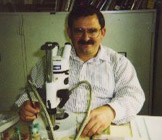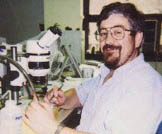BIODIVERSITY OF AUSTRALASIAN GROUND SPIDERS
SYSTEMATICS
In 1990 Platnick provided the first general cladistic analysis of the superfamily, based on the previously available data plus much new information obtained by scanning electron microscopy of spinneret spigot characters. That analysis argued for the monophyly of the superfamily (which currently contains about 150 genera and over 2,200 species worldwide), and its division into seven families.
The family Gnaphosidae was redefined to include just those gnaphosoids in which the anterior lateral spinnerets bear greatly enlarged and widened piriform gland spigots. The family Prodidomidae was revalidated and expanded to include the former gnaphosid subfamilies Molycriinae and Anagraphidinae as well as the prodidomines and zimirines; as relimited, the prodidomids are united by piriform gland spigots with greatly elongated bases accompanied by highly plumose setae. Gnaphosoids with piriform gland spigots lacking either type of modification were allocated to the Cithaeronidae, Gallieniellidae, Trochanteriidae, Ammoxenidae, and Lamponidae (which was removed from the Gnaphosidae and elevated to familial status). The genera of one other classical gnaphosoid family, the Platoridae, were transferred to either the Gnaphosidae or the Trochanteriidae, and Platoridae was considered a junior synonym of Trochanteriidae.
Subsequently, this classification has held up reasonably well, except in Australasia, where there are numerous problems at all taxonomic levels. An examination of the described Australasian gnaphosoids reveals a total of 37 genera and 131 described species. However, such a list is illusionary, obscuring as it does many taxonomic problems. First, whereas in the rest of the world recognition of members of the superfamily is relatively unproblematical, in Australasia this is not yet the case. Some of the Australian taxa currently considered gnaphosoids seem not to belong to the superfamily (the genus Battalus Karsch, for example, is probably a corinnid of the subfamily Castianeirinae, and may be a senior synonym of the relatively well-known Australasian genus Supunna Simon). At the same time, there are Australasian genera placed outside the superfamily that may well be gnaphosoids (for example, the genera Aristerus Simon, Asadipus Simon, and Centrothele L. Koch, currently placed in the corinnid subfamily Trachelinae), even though their character combinations are unlike those of gnaphosoids from other parts of the world.
At the family level, revising the Australasian gnaphosoids will thus provide the harshest possible test of the existing classification. For example, the family Lamponidae currently includes only Lampona Thorell, but there are several other genera (including the three supposed tracheline genera listed above) that may form a monophyletic group with Lampona. No members of the family Gallieniellidae have been described from Australasia, but the group is well represented there by several undescribed genera and many new species; however, the relationships of these taxa and of the clubionoid genus Meedo Main, which they resemble in many respects, remain to be worked out in detail.
In the Prodidomidae, one of the three currently accepted subfamilies, the Molycriinae, is exclusively Australasian, and easily recognized by the enormously elongated spinnerets, which originate near the front of the abdomen and can be moved by the spider in a wide swathe. Although only eight species have been described (in four genera), the fauna is at least four times that large. Still to be resolved are possible relationships with an undescribed South African species that has similarly modified spinnerets.
The recently reconstituted Trochanteriidae contains equally unusual spiders, with greatly flattened bodies (looking roughly like someone had dropped an unabridged dictionary on them!), but similarly modified taxa abound in the gnaphosid genus Hemicloea Thorell and its relatives, and the interrelationships of all these flattened taxa need to be worked out in detail before the limits of the Trochanteriidae can be resolved.
Within the Gnaphosidae itself, the described Australasian fauna represents only the tip of the iceberg. Almost all the Australian genera, of which there may eventually be three times the current 28, are endemic to the country. Those Australian species that were assigned (mostly in the last century) to northern hemisphere genera (such as Aphantaulax Simon, Echemus Simon, Micaria Westring, Sergiolus Simon, and Zelotes Gistel) are all misplaced. (Interestingly, however, one true species of Zelotes, a genus otherwise native only to the Holarctic and Ethiopian regions, does occur in Australia, but is a widespread species found north to Pakistan and Borneo).
Thus, although it cannot be argued that the various Australasian genera that will be monographed during this project represent a single monophyletic group, they clearly represent a limited number of such groups, and that selection is well suited to testing the existing familial classification. Moreover, the faunas in which the closest relatives of these groups will be found are manageable. For example, the gnaphosoid fauna of New Guinea and the islands of the Indo-Pacific is extremely depauperate, and shows few if any close relationships to Australasian taxa.
The gnaphosoid fauna of New Zealand, moreover, has been revised by Forster, and the fauna of New Caledonia is already under study by Platnick, who has made three expeditions to that island (and also collected in New Zealand, Tasmania, and the Australian mainland, as well as extensively in Chile). Indeed, the New Caledonian fauna shows a spectacular radiation in the genus Hypodrassodes Dalmas; although only three species have been described from New Caledonia, the fauna contains at least 28 different species. Documenting these taxa, and investigating their relationships with the seven Hypodrassodes species described from New Zealand, will form an important part of this project (the 11th species currently assigned to the genus, from the New Hebrides, was misplaced as a gnaphosoid and has been transferred to the Miturgidae by Platnick and Bonaldo).
Large collections of Australasian gnaphosoids are available for this project, from the Queensland Museum, Australian Museum, CSIRO, Museum of Victoria, Western Australian Museum, South Australian Museum, and Northern Territory Museum. The total number of relevant specimens available for the project in Australian and other collections (only the American Museum, the Museum of Comparative Zoology, and the California Academy of Sciences hold significant Australian spider collections) will probably reach 20,000. Based on Raven's estimate (probably quite accurate) that only about 20% of the Australian spider fauna has been described to date, we estimate that a total of about 650 species will be monographed during this project.
PERSONNEL
 Dr. Norman I. Platnick
Dr. Norman I. Platnick
Dr. Norman I. Platnick received his undergraduate degree from Concord College (Athens, WV), his master's from Michigan State University, and his Ph. D. from Harvard. Since 1973, he has been curator at the American Museum of Natural History, including a seven-year stint as Chairman of the Entomology Department. He has published on a wide variety of spider groups, and also on the obscure arachnid order Ricinulei.
 Dr. Vladimir Ovtsharenko
Dr. Vladimir Ovtsharenko
Dr. Vladimir Ovtsharenko is a spider taxonomist and Research Scientist in the Department of Entomology, American Museum of Natural History, where he has worked for five years. He is also Curator of arachnological collections and Senior Scientist at the Zoological Institute of the Russian Academy of Sciences. He holds a M. Sc. in Biology from St. Petersburg State University, where he studied the spider fauna of the Caucasus mountains. In 1983 he obtained his Ph.D. from the Zoological Institute, RAS, studying the gnaphosids of the European part of the former USSR. He has extensive experience curating museum collections and has worked with spider collections in the all major museums of the USA, Europe, Asia, Africa, and Australia and has also collected spiders on all these continents. The author of some forty scientific and popular articles and an active teacher, he has taught at the St. Petersburg Pedagogical University and the Education Department of the American Museum of Natural History.
 Dr. Kefyn M. Catley
Dr. Kefyn M. Catley
Kefyn Catley, a native Welshman, holds a B.Sc. Hons. in Zoology from the University of Wales where he studied the ecophysiology of upland spiders, and a Masters from Western Carolina University working on the systematics and behavior of lampshade spiders (Hypochilidae). He earned his Ph.D. from Cornell University revising the hahniid spiders of austral South America. Traveling extensively, he has studied spider biodiversity in South America, Europe, the USA, Canada, and Australia. The author of various scientific papers and popular articles and an enthusiastic educator, he frequently gives presentations and workshops on many aspects of the natural world and teaches biodiversity classes for the Education Department of the American Museum of Natural History. He lives in New Jersey with his wife and daughter.
 Dr. Boris Zakharov
Dr. Boris Zakharov
Boris Zakharov graduated from the Far-East State University (Vladivostok, former USSR) in 1979 with a Masters Degree, his thesis was entitled " Orb-weaver spiders (Arachnida, Araneae: Araneidae) of Primorskey Kraie (the south part of Russia's pacific coast )". After graduation he worked in various organizations in the fields of wildlife protection and pest control. In 1989 he obtained his Ph.D. degree from the Zoological Museum of the Biological Institute (Novosibirsk, former USSR); his dissertation was "Fauna and ecology of horse-flies (Insecta, Diptera: Tabanidae) of south-west Transbaicalia (the south region of east Siberia )". He has recently joined the PEET team at the American Museum of Natural History as a Curatorial Assistant. His main duties involve processing material, preparing illustrations, and dealing with literature and correspondence.
AMNH Spider Home Page | Go Top
© American Museum of Natural History, Last updated: November 5, 1997
This page is maintained by Kefyn Catley
 Dr. Norman I. Platnick
Dr. Norman I. Platnick
 Dr. Vladimir Ovtsharenko
Dr. Vladimir Ovtsharenko
 Dr. Kefyn M. Catley
Dr. Kefyn M. Catley
 Dr. Boris Zakharov
Dr. Boris Zakharov